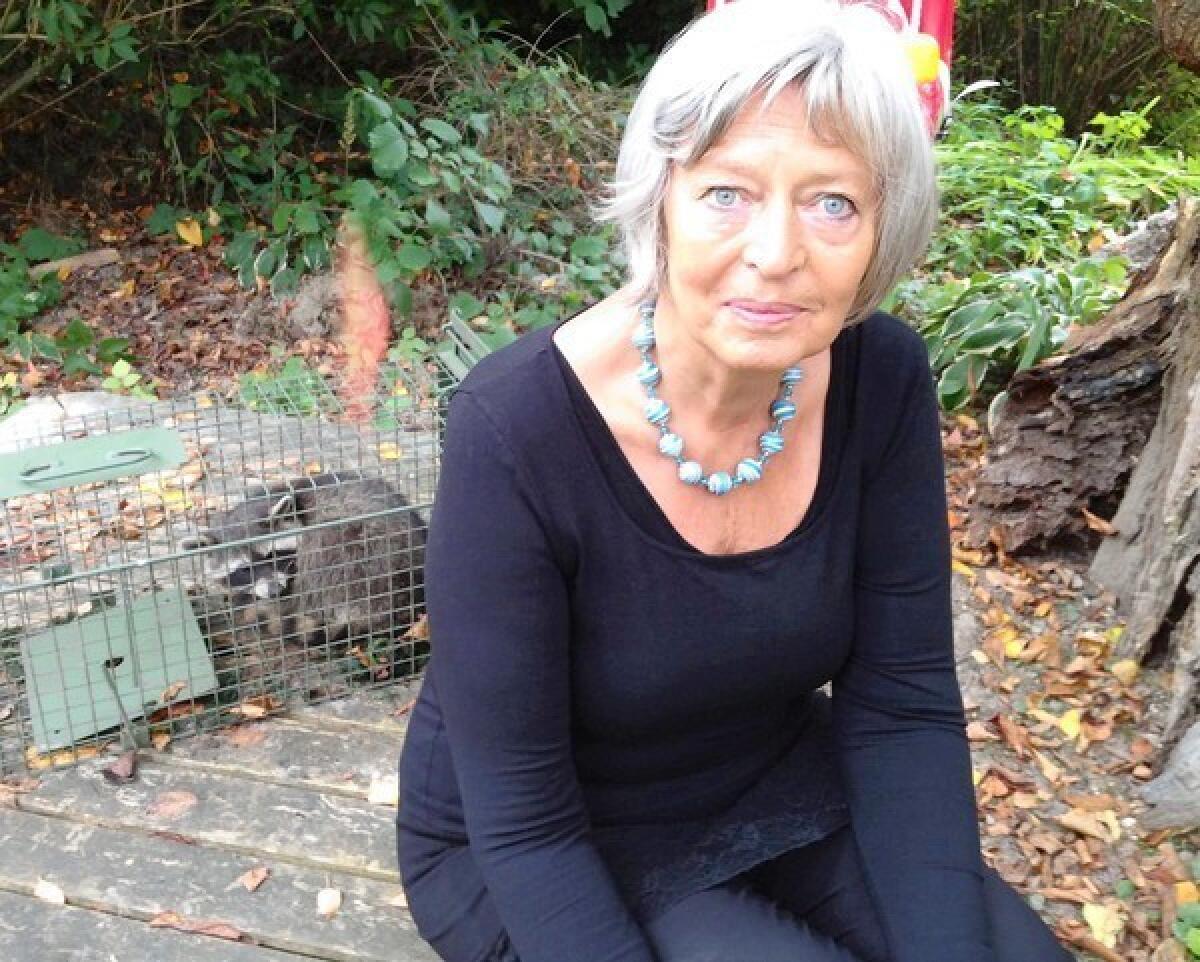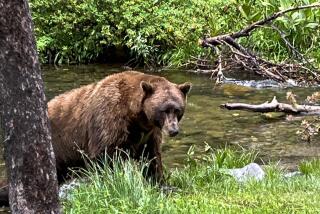Unfortunately for Germany, it’s ‘a wonderland for raccoons’

NIESTE, Germany — The masked intruders who come regularly after dark don’t fill Marga Trautmann-Winter with dread so much as irritation — lots of it.
She finds evidence of their larceny at daybreak in her backyard, where plums have been pilfered, cherries picked and apples appropriated from her small orchard. But if she’s lucky, she manages to turn the tables and ensnare one of the thieves, as has happened about 20 times in the last two years, including one recent morning.
The bandit lay curled up in a metal cage, its drowsy expression turning to wariness, then narrow-eyed aggression as Trautmann-Winter approached.
“They look very smart, but I think they are very dangerous,” she said, as the captive hissed and bared its teeth. “And they are a problem for us.”
A big one, it turns out. A species first imported from the United States in the 1930s, Germany’s raccoon population is exploding and encroaching on the human environment more than ever before. That has many residents here up in arms — literally, in the case of hunters strapping on their rifles and heading into the woods to help stem the tide of hungry ring-tailed pests.
But they’re fighting a losing battle. Their furry, fertile and firmly established enemy fills an unoccupied niche in the local ecology, unmolested by natural predators, and has successfully colonized this country in less than a century since arriving from its faraway native habitat.
“It’s a present of the American people,” Derk Ehlert, chief wildlife officer for the city of Berlin, said dryly.
In the German capital, raccoons once confined to the forested margins now make regular appearances in the city proper, including one that popped up in busy Alexanderplatz, a square full of tourists and shoppers. Overturned trash cans on leafy residential streets attest to nocturnal forages.
This month, to the bewilderment of other passengers, two raccoons boarded a subway train, said Ehlert, who did not know the pair’s final destination. Excited, anxious or nonplused Berliners constantly ring up his office to report sightings.
“We’re getting 50 calls a day…. I know of at least 500 raccoon families in the city,” Ehlert said. “They are the most intelligent mammals in Europe. They’re very quick.”
They’re also highly mobile, at least the males, which can travel long distances (without benefit of public transport) in search of mates as well as food to sate their ravenous appetites. Scientists were surprised to discover that one raccoon had migrated more than 100 miles, far more ground than they had thought the animals could cover.
That has heightened fear of an expansion across man-made borders. The vast majority of Europe’s raccoons live in Germany, said zoologist Ulf Hohmann, but many neighboring nations have already recorded their presence.
Leave it to Britain’s jingoistic Sun tabloid, never one to mince words or miss a chance to stick it to the Germans, to warn hysterically of “Nazi raccoons on [the] warpath,” marching across the Continent toward the English Channel “just like the Nazis did.” An illustration of a masked raccoon, foreleg raised with a swastika-stamped red armband, punctuated the point.
The Nazi reference springs in part from an account of the raccoon’s origins in Germany that zoologists and wildlife biologists like Ehlert say is a myth.
The story has it that one of Hitler’s closest advisors, military leader Hermann Goering, personally ordered the release of imported raccoons into Germany’s forests, either to foster biodiversity — in utter contrast to the Nazis’ evil ideology of human racial purity — or to increase the number of game animals for Germany’s avid hunters.
Ehlert said a forestry official did release two pairs of raccoons from the United States into the wild in 1934 to promote diversity of fauna, though Goering had nothing to do with it. Then, during World War II, a bomb destroyed a farm near Berlin where raccoons were being raised for their pelts, allowing about 20 of the critters to escape.
These two dozen ancestors essentially gave rise to today’s raccoon population in Germany, which is impossible to tally exactly but which Hohmann estimates is edging toward the 1 million mark.
In one indicator of their proliferation, nearly 68,000 raccoons were shot during the hunting season that ended in early 2011, the last period for which figures are available. Ten years earlier, the number was about 9,000.
“It’s really incredible what the species is doing at the moment,” Hohmann said. Germany’s temperate climate and extensive forest cover “fits perfectly what the raccoon needs. It’s mild. They love water. We have a lot of rain…. It’s a wonderland for raccoons.”
Humans are a godsend as well. As litterers, food wasters and suckers for cute-looking animals, humans unwittingly or deliberately help satisfy raccoons’ ravenous appetites. (The German word for raccoon, waschbaer, or wash bear, derives from the creature’s habit of washing its food with its highly sensitive paws).
The most heavily besieged urban area is the central German city of Kassel, where raccoons have become the stuff of daily headlines.
Here in Nieste, a small town nine miles east of Kassel, the animals are a scourge for residents such as Trautmann-Winter, whose backyard, where her grandchildren like to play, is covered with raccoon droppings after the animals feast on her fruit trees at night. She often looks out her kitchen window in the evenings to see a family of raccoons scampering across her neighbor’s rooftop.
Curious and adaptable, the four-legged interlopers have pried up roof tiles and chewed through insulation to nest in the warm eaves of houses. They raid horses’ feed troughs for snacks.
Edgar Paul, an enthusiastic hunter, says he shot and killed a raccoon about once every two weeks, on average, in the surrounding woods last year. Hunting is not allowed in areas of human habitation. Trying to figure out what to do about the raccoon invasion is now one of his biggest headaches as Nieste’s mayor.
“The problem isn’t the forest. If they lived in the forest, they’d be easy to get rid of,” Paul said. “They live in the town now, in roofs, and there you can’t get rid of them.”
Fed-up Germans have suggested mass hunts to try to solve the problem, but evolution has doomed such efforts to almost certain failure, because raccoons can adjust their breeding patterns to help compensate for lost numbers when their population is under stress.
In any case, animal-rights activists deplore the idea of widespread killing or trapping, noting that raccoons pose no physical threat to humans, who would do better just to secure their garbage cans and plug gaps in their walls to discourage forays into town.
“I’ve never heard of a raccoon attacking someone…. No raccoon has ever stolen a baby,” said Beate Kaminski, a spokeswoman for the Tierschutzverein (Animal Protection Society) in Berlin, which operates Europe’s largest animal shelter.
“They can be annoying — I can understand that — but again, it’s no reason to go out and shoot anything that moves in your garden,” Kaminski said.
Probably the only thing capable of wiping out large numbers of raccoons is illness, but that’s up to nature. Humans, said Hohmann, should best resign themselves to an uneasy coexistence.
“I think our grandchildren will regard them as a part of the natural habitat. It’s our generation that still remembers they came to Europe artificially,” he said. “Just accept it. We don’t have a chance.”
More to Read
Sign up for Essential California
The most important California stories and recommendations in your inbox every morning.
You may occasionally receive promotional content from the Los Angeles Times.











